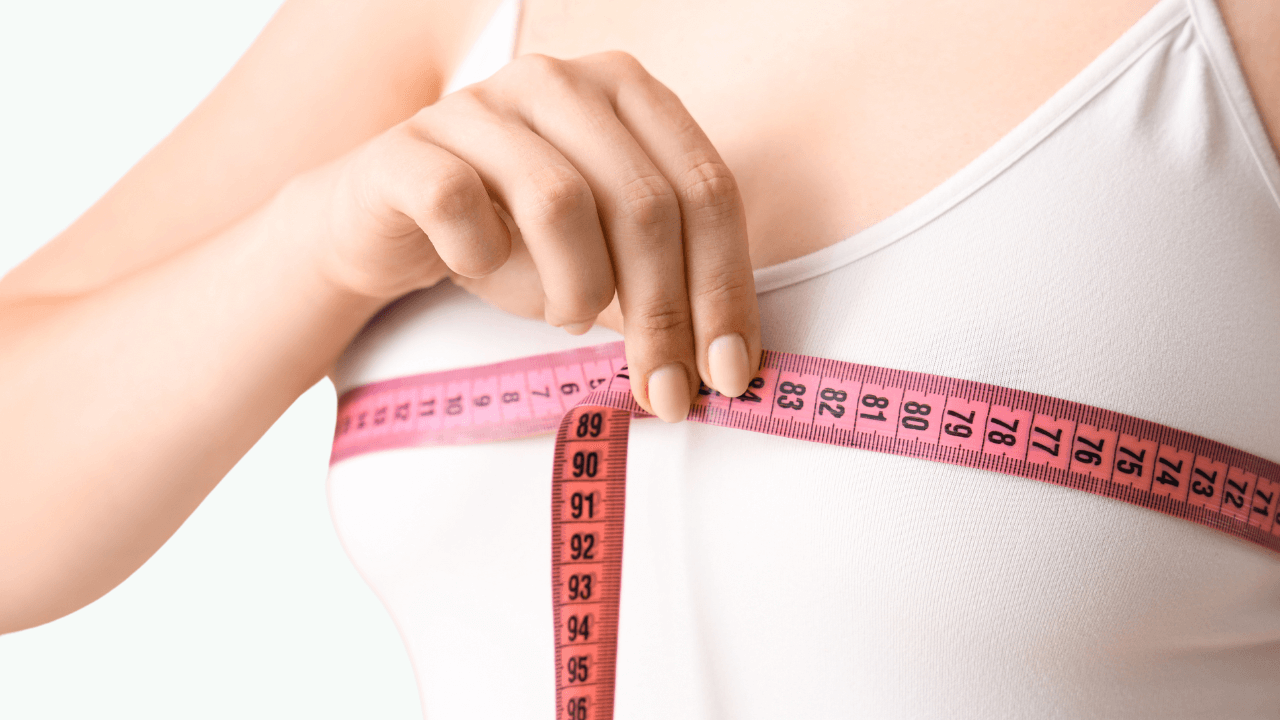

The breasts are made of glandular and adipose tissues with attached hormone receptors. Hormonal changes in the body, particularly in women, may cause these tissues to expand and lead to enlarged breasts.
The weight and size of larger breasts may cause issues like back pain, neck strain, and difficulty engaging in physical exercises comfortably.
Research indicates that having larger breasts may cause the body to store fat in areas beyond just under the skin, such as intermuscular and visceral regions. Larger breasts could sometimes pose challenges, leading to discomfort and limitations in daily activities.
Here, we shall examine the effect of breast size reduction, offering valuable insights and practical tips for those seeking to lose breast fat.

Certain medications may potentially cause unintended breast enlargement as a side effect. Hormonal treatments like birth control pills, injections, or hormone therapy might lead to an increase in breast size.
Substances like recreational marijuana, anabolic steroids, and certain antidepressants could also lead to breast enlargement.
Monitoring changes in breast size while on medication and discussing concerns with a doctor may help you make informed decisions.
Hormonal changes boost the ovaries to increase the production and release of estrogen, a primary female sex hormone. The increase in estrogen levels may trigger fatty tissue accumulation in the breasts, potentially leading to breast growth.
Progesterone, another sex hormone, complements estrogen’s effects. Together, these hormones may induce weight gain and increase fat deposition in the breast tissues.
Hormonal fluctuations occur throughout menstruation and may cause temporary changes in breast fullness and tenderness.
During pregnancy, elevated estrogen and progesterone levels prepare the breasts for milk production, potentially leading to increased breast size.
As you age, hormonal balance and metabolism changes might influence the size and composition of breast tissue. The body’s metabolism declines with age, which may contribute to weight gain and fat deposition in your breast tissues.
The natural aging process could decrease skin elasticity, possibly contributing to sagging breasts. Collagen and elastin production in the skin tends to decrease with age, leading to a loss of firmness in the breast area.
Lifestyle factors often accompanying aging, such as reduced physical activity levels and dietary habits, can also play a part. These factors might influence body weight and fat distribution, potentially affecting breast size.
Factors like aging and hormonal fluctuations could sometimes lead to conditions such as breast hypertrophy. It may trigger uncontrolled enlargement in one or both breasts that could cause physical discomfort and hinder daily activities and self-esteem.
Debilitating symptoms, such as breast pain (mastalgia), infections or abscesses, loss of nipple sensation, or poor posture, may accompany breast hypertrophy.
Women with breast hypertrophy should have regular check-ups with healthcare providers to monitor any changes and address concerns promptly. Severe cases of breast hypertrophy may require surgical interventions like breast reduction surgery.
Hormonal fluctuations and physical adaptations during pregnancy and breastfeeding may lead to noticeable differences in breast size and texture.
The mammary glands expand in preparation for breastfeeding, causing an increase in breast size. Breast enlargement is a natural response to hormonal changes required for nourishing the baby.
During pregnancy or lactation, you may experience lumpiness or a denser feeling in your breasts due to increased blood flow and the growth of mammary glands. It is a normal occurrence as the body prepares for milk production.
After weaning, you might notice a decrease in breast size as the mammary glands regress to their pre-pregnancy state.
Genetics plays an important part in determining the size and shape of your breasts. The inheritance of breast size is complex and influenced by combined genetic factors from both parents. Women with a family history of large breasts may have a genetic predisposition to larger breast sizes themselves.
Genetic variations may impact the development of breast tissue, affecting factors like volume, density, and distribution. Hormones and growth factors regulated by specific genes might impact breast growth and development.
Mutations or gene variations could lead to conditions like breast hypertrophy, where one breast grows significantly larger than the other.
Autoimmune conditions like lupus could trigger the immune system to attack healthy breast tissue, causing inflammation and potential swelling.
Inflammation from autoimmune responses may result in temporary or persistent alterations in breast size due to fluid retention or tissue swelling.
Autoimmune conditions affecting the breasts may lead to discomfort, changes in breast texture, and fluctuations in size.
Consultation with healthcare providers, adherence to treatment plans, and lifestyle adjustments might help mitigate these effects.
Weight fluctuation might cause a change in breast size and alter their fat distribution. If you gain weight, the excess fat may accumulate in your breasts, causing them to appear more prominent.
The breast tissue is responsive to shifts in the body’s overall fat composition. As you experience fluctuations in weight, your breasts may also undergo changes in size and shape. Conversely, significant weight loss may result in a reduced breast size.
Strength training exercises targeting the chest muscles could help tackle your concerns about chest size and appearance. Some of these exercises may include
Combining these exercises with a calorie-controlled diet and cardiovascular activities may aid in reducing overall fat composition.
You can also include cardio exercises such as swimming, jogging, high-intensity interval training, or rope skipping. These simple changes in your routine might help you reduce overall body fat, including breast fat.
However, seeking guidance from a fitness professional could provide appropriate advice to help you achieve your goals of reducing breast fat.
| Exercise | Benefits |
|---|---|
| Push-ups | Strengthens chest muscles |
| Chest presses | Targets chest muscles for toning |
| Chest flyes | Helps shape and strengthen chest muscles |
| Walking, Jogging, Cycling | Burns overall body fat, including chest fat |
Regular exercise may help burn calories, boost metabolism, and improve cardiovascular health. Including a variety of workouts may contribute to reducing overall body fat, which may include fat from the breasts.
Focusing on high-intensity aerobic exercises could reduce breast size, as breasts primarily consist of fatty tissue.
Examples include cycling, stair-climbing, or skipping rope, which may increase calorie burning and reduce body fat.
Pushups and chest-focused exercises like chest presses or dumbbell flyers can tone and strengthen your chest muscles. However, doing strength training and chest-targeting exercises alone may not reduce your breast size.
Combining strength training exercises and cardio is valuable for effectively utilizing the benefits of exercise in losing breast fat.
| Exercise | Type | Benefits |
|---|---|---|
| Push-ups | Strength training | Targets chest muscles for toning and strength |
| Cycling | Cardiovascular | Burns calories and aids in overall fat reduction |
| Swimming | Full-body workout | Tones chest muscles and promotes fat loss |
Your dietary choices impact your body fat levels and overall weight, including breast size. You should consume a low-fat diet that promotes weight loss to help reduce your breast fat levels.
Nutrient-rich, low-calorie foods like fruits, vegetables, nuts, healthy fats from fish, and lean meats may support weight loss goals. These food choices may improve satiety and contribute to potential BMI changes, impacting the appearance and size of your breasts.
Refraining from processed foods and focusing on whole, natural options can enhance fat-burning and overall health. Maintain adequate hydration levels by drinking at least eight glasses of water daily to support fat loss.
Selecting a properly fitting and supportive bra may enhance comfort levels and mitigate the appearance of enlarged breasts and posture issues.
While a bra cannot alter your breast size, minimizer bras may create the illusion of smaller breasts by altering breast shape to appear flatter and higher on the chest. These bras may have supportive straps, helping reduce back and neck pain associated with larger breasts.
Hormonal irregularities may fluctuate estrogen (a hormone crucial in breast tissue development) levels and might lead to increased breast size.
Contraceptives containing estrogen and progesterone could cause breast enlargement, with effects often reversing upon discontinuation of the medication.
Dietary modifications like adopting a Mediterranean-style diet, decreasing alcohol consumption, and increasing physical activity could help reduce estrogen levels naturally. Foods like flaxseeds, oats, green tea, lean proteins, and whole grains may also aid in lowering estrogen levels.
Consult a doctor for guidance on estrogen-lowering medications and the appropriate use of herbal remedies to reduce estrogen levels.
Binding offers a temporary way to achieve a flatter chest appearance without permanent changes to breast tissue. During binding, constrictive materials like cloth strips are wrapped firmly around the breasts to give them a flatter appearance.
Using breathable materials and ensuring the binding promotes comfortable breathing is essential.
Before starting to bind, you may consult a doctor or a specialist to understand the safest practices for binding. They could guide you on duration, material selection, and potential risks.
Massaging your breasts could promote lymphatic drainage and improve blood circulation around the breasts. These effects might help reduce breast size by soothing inflammation and swelling in the breast tissues.
Breast massages may enhance the firmness and flexibility of breast tissue and aid in early breast cancer detection (through self-examination).
Opting for specific oils like flaxseed or olive oil during breast massages may provide additional advantages.
Flaxseed oil has shown potential in lowering estrogen levels, which could contribute to reducing breast size. Using olive oil during a breast massage may improve blood circulation and skin stimulation, potentially aiding in breast size reduction. However, the scientific evidence backing such claims is limited.
Herbs like fenugreek, ginger, turmeric, and green tea may contain fat-burning properties. Adding these herbs to your diet or as a concoction may aid in reducing overall body fat, including breast fat.
Green tea contains potent antioxidants that could boost your metabolism by burning calories and fat. The reduced fat buildup might contribute to a reduction in your breast size.
Flaxseeds have a high omega-3 fatty acids content that may regulate estrogen levels, potentially curbing breast enlargement. Adding flaxseeds to your foods or drinks could provide you with these benefits.
Certain herbal remedies, like dandelion root, red clover, and saw palmetto, are believed to impact estrogen levels and hormone regulation. Using these herbal remedies might help reduce your breast size.
The scientific evidence supporting the efficacy of these herbal remedies in reducing breast fat is limited. Consult a doctor before considering these herbal remedies.
Although aesthetically appealing to many individuals, having large breasts may pose various health risks. You may experience physical discomfort like back and neck pain, shoulder pain, or postural issues due to the weight of larger breasts.
Understanding the factors contributing to breast enlargement and exploring effective strategies for managing body fat might work toward losing breast fat.
Natural measures like maintaining a moderate weight, wearing a comfortable bra, and getting a breast massage may aid in reducing breast fat. Surgical interventions like mammaplasty could also help if natural means do not work.
However, you should consult a specialist or a doctor about your concerns about breast size. They could provide guidance, suggest treatment modalities, and disclose the potential health complications associated with your breast concerns.
Tyler Read earned an undergraduate academic degree from Sonoma State University, California and is a certified personal trainer (CPT) with NASM (National Academy of Sports Medicine). With over 16 years of experience, Tyler has trained clients both online and in-person.
He is passionate about helping others turn their love for fitness into a career. Tyler has worked with many local and commercial gyms before establishing his successful private personal training business, which he continues to operate.
